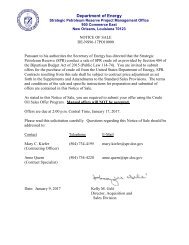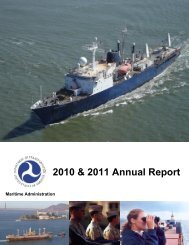Create successful ePaper yourself
Turn your PDF publications into a flip-book with our unique Google optimized e-Paper software.
U.S. NAVY<br />
The Gold Crew of the Ohio-class ballistic-missile submarine USS Kentucky transits the Hood Canal in Puget Sound, Wash., as the boat returns home to Naval<br />
Base Kitsap-Bangor Sept. 28, 2016, following a routine strategic deterrent patrol. Kentucky is one of eight ballistic-missile submarines stationed at the base.<br />
in the 1970s and commissioned between 1984 and 1997,<br />
these submarines already have seen a service-life extension<br />
from 30 to an unprecedented 42 years. A phased<br />
replacement program must continue to be a priority to<br />
ensure continuity of the operational force, ultimately<br />
resulting in a new, 12-boat Columbia-class SSBN Force.<br />
The replacement of these dedicated, uniquely configured<br />
strategic submarines occurs roughly every half century,<br />
creating a procurement requirement outside of the Navy’s<br />
phased ship construction program geared to support<br />
“normal” fleet operations. The Columbia class, formerly<br />
known as the Ohio Replacement Program, is saving development<br />
costs by applying existing submarine equipment<br />
(Trident II missiles, Ohio- and Virginia-class components)<br />
to the design. Additionally, the U.S. and U.K. Royal<br />
navies are developing a common missile compartment for<br />
their respective new SSBN platforms under a cost-sharing<br />
agreement between our two nations.<br />
Nevertheless, the relatively high cost of these unique,<br />
critical SSBNs and the phasing and duration of the total<br />
force construction effort creates an unrealistic and unaffordable<br />
funding requirement for incorporation into<br />
the existing Navy budget. Accordingly, the Navy League<br />
most strongly recommends the Columbia class be funded<br />
outside the existing Navy SCN account and protected<br />
from budget cuts in recognition of the unique national,<br />
strategic mission of these platforms and to prevent the<br />
significant, unavoidable impact and disruption to Navy<br />
ship construction programs and the conventional ship<br />
construction industry. The fiscal 2015 National Defense<br />
Authorization Act created such an account — the National<br />
Sea-based Strategic Deterrent Fund — and it must be<br />
funded by congressional appropriators.<br />
The sustained, forward-deployed presence of the U.S. Navy,<br />
Marine Corps, Coast Guard and U.S.-flag Merchant Marine<br />
ships in the South China Sea, Arabian Gulf, Indian Ocean<br />
and Northeast Asia strengthens our partnerships, ensures<br />
access to sea lanes and promotes engagement with friends<br />
and competitors alike. The combined influence of our<br />
nation’s diplomacy and the presence of these forward-deployed<br />
maritime forces help prevent heightened tensions<br />
from escalating into conflict. Maritime forces usually are<br />
the first to respond because they are forward, they are<br />
ready and they are versatile. The power and potential of a<br />
forward-deployed naval force ready and able to respond<br />
within hours instead of days is unparalleled.<br />
As our military and intelligence officers have testified<br />
before Congress, we are facing a return to great-power<br />
competition. Investments by other countries, notably<br />
China and Russia, in their own navies should push the<br />
United States to invest in its sea services to maintain its<br />
naval advantage.<br />
4<br />
NAVY LEAGUE OF THE UNITED STATES




